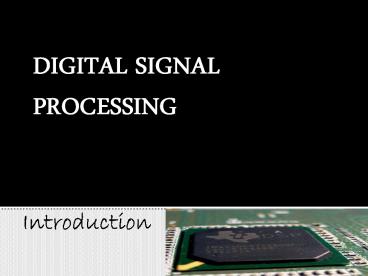DIGITAL SIGNAL PROCESSING - PowerPoint PPT Presentation
1 / 31
Title:
DIGITAL SIGNAL PROCESSING
Description:
Introduction. DIGITAL SIGNAL ... Discrete Time Fourier Transform ... Practical computation of DTFT: the discrete Fourier transform(DFT), computation of the DFT (FFT) – PowerPoint PPT presentation
Number of Views:306
Avg rating:3.0/5.0
Title: DIGITAL SIGNAL PROCESSING
1
Introduction
- DIGITAL SIGNAL PROCESSING
2
Course information
3
Course information(C0ntd..)
4
Discrete Time signal
- Sequence xn as opposed to continuous time
signals x(t)
5
Discrete in Nature
- Population statistics
- Stock market indices
6
Sampled continuos time (analog) signals
- Example
- Speech
7
Applications
8
Speech Processing
Original speech
High pass
Down sample
Low pass
Up sample
9
Image Processing
10
Video Processing
General Concept
Object 1
Motion Analysis
Object 2
Video Synthesis
Applications
Analysis
11
Discrete-Time System
y(n)Tx(n)
12
Why DTSP?
- Discrete Time Signal Processing of Continuous
Signals
x (n)
y (n)
y(t)
x (t)
13
Why DTSP?
Digital Signal Processing (DSP) is derived from
DTSP
y(n)
y(n)
x(t)
x(n)
14
(No Transcript)
15
Discrete Time Signal
16
Where Not?
17
DSP COMPONENTS
- Converting analog signal into digital sequence.
- Performing all signal processing operations in
digital in digital form. - If necessary converting the digital information
back to analog signal. - A TYPICAL DSP SCHEME
DAC
DSP Processor
ADC
Analog Filter
Analog Filter
18
WHY DSP?
19
Frequency Selective Filtering
20
Echo Cancellation
21
DSP SOLUTION TO EC
22
Equalization
23
Speech Transmission
24
Image Processing
25
Image Processing
26
DSP in real time embedded systems
27
Comparison of Chips
POWE R CONSUMP T I ON
FLEXIBILITY
28
Comparison of Chips
ASIC FPGA µP/µC DSP Processor
Flexibility None Limited High High
Design Time Long Medium Short Short
Power Consumption Low Low- Medium Medium- High Low- Medium
Performance High High Low Medium Medium-High
Development Cost High Medium Low Low
Production Cost Low Low- Medium Medium-High Low-Medium
29
Course Outline
30
Course Outline
31
Course Outline
- DSP A/D,D/A
- System Design and Implementation
- Practical computation of F































